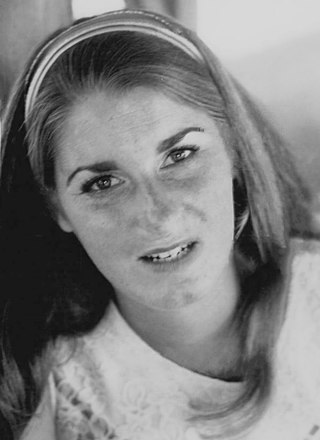
Rafael Osuna Herrera , nicknamed "El Pelón", was a former world No. 1 tennis player, the most successful player in the history of Mexico and an Olympian. He was born in Mexico City, and is best remembered for his singles victory at the U.S. Open Championships in 1963, winning the 1960 and 1963 Wimbledon Doubles championships, the 1962 U.S. Open Championships doubles, and for leading Mexico to its only Davis Cup Final round appearance in 1962. He is the only Mexican to date to be inducted into the International Tennis Hall of Fame, in 1979.

Helga Niessen Masthoff is a retired tennis player from West Germany. Her best Grand Slam singles tournament was when she reached the 1970 French Open final, losing to Margaret Court in straight sets. She won the German Open three consecutive years from 1972 through 1974, beating Martina Navratilova in the 1974 final in three sets. Masthoff was the runner-up at that tournament in 1971, losing to Billie Jean King.
Tennis returned to the Summer Olympic program as an exhibition and a demonstration event in 1968. Men's and women's singles and doubles and mixed doubles were held in both, a Demonstration tournament and an Exhibition tournament. The Demonstration tournament was held in Guadalajara and the Exhibition tournament in Mexico City.
Gladys Medalie Heldman was an American tennis player, manager and magazine publisher. She was the founder of World Tennis magazine. As a manager, she supported and represented Billie Jean King and eight other female tennis players: Rosie Casals, Judy Dalton, Julie Heldman, Kerry Melville, Peaches Bartkowicz, Kristy Pigeon, Nancy Richey, and Valerie Ziegenfuss. They were called the Houston Nine and formed the Virginia Slims Tour in the early 1970s. She is a member of the International Tennis Hall of Fame and the International Jewish Sports Hall of Fame.

Edda Buding was a German tennis player of Romanian birth. She received the doubles gold medal at the 1968 Summer Olympics doubles demonstration event partnered with Helga Niessen Masthoff. Along with Yola Ramírez Ochoa, she was the runner-up in the 1961 U.S. Championships women's doubles event and with Robert Howe was the runner-up in mixed doubles at Wimbledon in 1961. She was the sister of Ingo Buding, a two-time junior singles champion at the French Championships, and Ilse Buding.
The Virginia Slims Circuit was a tennis tour consisting of a group of originally nine female professional players. Formed in 1970, the Virginia Slims Circuit eventually became the basis for the later WTA Tour. The players, dubbed the Original 9, rebelled against the United States Lawn Tennis Association (USLTA) because of the wide inequality between the amount of prize money paid to male tennis players and to female tennis players.

Valerie Bradshaw is an American former female professional tennis player. She started as an amateur player at the beginning of the 1970s, then turned professional.
The Original 9 were a group of nine women's professional tennis players who broke away from the governing bodies of tennis in 1970 to launch their own professional tour, the Virginia Slims Circuit, which later evolved into the modern WTA Tour.
Vladimir Viktorovich Korotkov is a retired Soviet tennis player who won three Junior Grand Slam tournaments, Wimbledon Juniors in 1964, 1965 and French Juniors in 1965. He also won the mixed doubles at the 1968 Summer Olympics where tennis was a "demonstration sport". He won the men's doubles event at the 1973 Summer Universiade and the 1977 USSR singles championship. Since 1981 and until his retirement in 1996, Korotkov was coaching at several sports clubs.
Rosa María "Rosie" Reyes Darmon is a retired tennis player from Mexico who was active in the 1950s and 1960s.
The 1969 German Open Championships was a combined men's and women's tennis tournament played on outdoor red clay courts. It was the 61st edition of the tournament, the second one in the Open Era, and the first edition to offer official prize money. The event took place at the Am Rothenbaum in Hamburg, West Germany, from 5 August through 11 August 1969. First-seeded Tony Roche and Judy Tegart won the singles titles. Tegart also won the doubles and mixed doubles titles.
Since the 1968 Summer Olympics did not feature tennis as an official sport, two unofficial tournaments were held during the Games: a Demonstration tournament and an Exhibition tournament.
Since the 1968 Summer Olympics did not feature tennis as an official sport, two unofficial tournaments were held during the Games: a Demonstration tournament and an Exhibition tournament.
Since the 1968 Summer Olympics did not feature tennis as an official sport, two unofficial tournaments were held during the Games: a Demonstration tournament and an Exhibition tournament.
Since the 1968 Summer Olympics did not feature tennis as an official sport, two unofficial tournaments were held during the Games: a Demonstration tournament and an Exhibition tournament.
Since the 1968 Summer Olympics did not feature tennis as an official sport, two unofficial tournaments were held during the Games: a Demonstration tournament and an Exhibition tournament.
Since the 1968 Summer Olympics did not feature tennis as an official sport, two unofficial tournaments were held during the Games: a Demonstration tournament and an Exhibition tournament.
Since the 1968 Summer Olympics did not feature tennis as an official sport, two unofficial tournaments were held during the Games: a Demonstration tournament and an Exhibition tournament.
Since the 1968 Summer Olympics did not feature tennis as an official sport, two unofficial tournaments were held during the Games: a Demonstration tournament and an Exhibition tournament.
Since the 1968 Summer Olympics did not feature tennis as an official sport, two unofficial tournaments were held during the Games: a Demonstration tournament and an Exhibition tournament.



